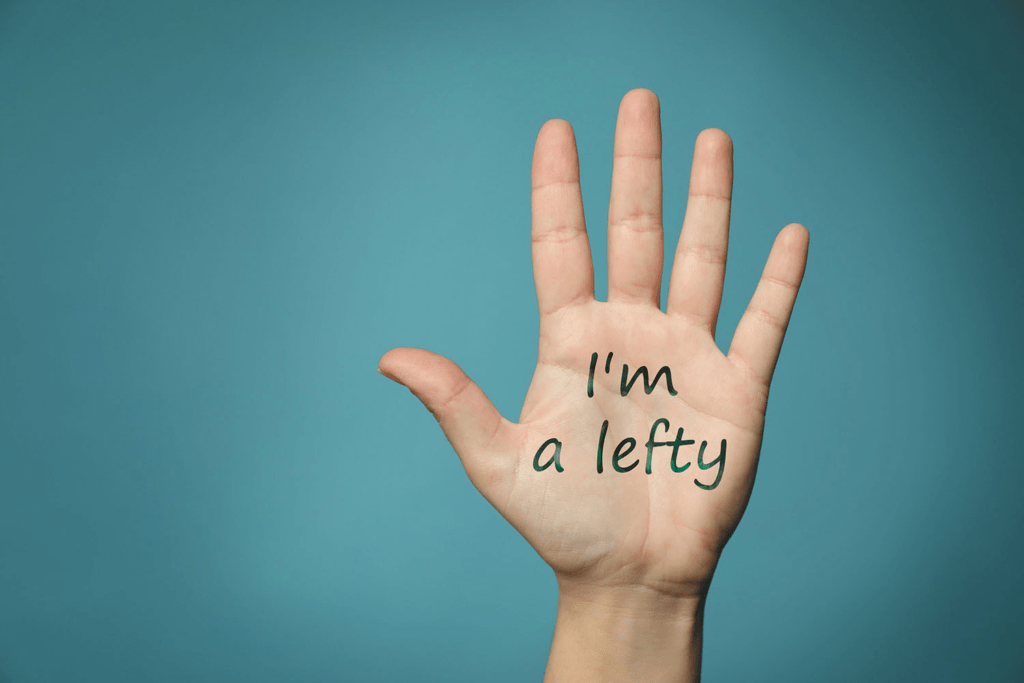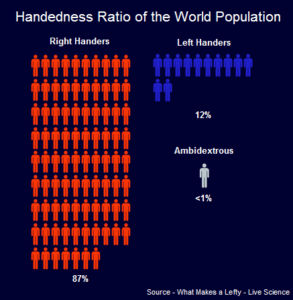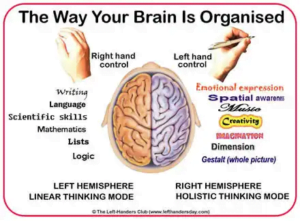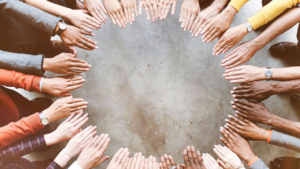
The majority of the people in this world are right-handed. Left-handed individuals make up approximately 12% of the population, versus the 87% for the righties, and the 1% of people who are ambidextrous (able to use both hands equally). Although there is not a black and white answer to why some people are left-handed, researchers believe that there has always been a significantly larger number of people who are right-handed in this world based on several criteria.

- Findings of ancient skeletons and examinations of the wear patterns on prehistoric tools.
- Fetuses start to move their arms around nine to ten weeks and early in the second trimester, the baby shows a clear preference for sucking one thumb over the other. Handedness is probably hardwired before birth. However, there is no evidence to say this with 100% assurance and most development experts state parents likely will not get a clear sense of their child’s prevalent hand until age two or three. Many kids continue to switch hands for different tasks during early childhood. Look more into fetal discoveries by reading Histories of Fetal Knowledge Production in Sweden: Medicine, Politics and Public Controversy, 1530–2020 by Solveig Jülich. Salina Public does not have this item in their collection, but please ask about interlibrary loan for this and other titles that interest you.
- In a 2019 study, it was identified that there are differences in parts of the DNA based on if someone is left or right-handed. This same study found that for lefties, the parts of the right and left sides of the brain that process language work in better tandem.
- It is also believed that handedness develops based more on the need for competition versus cooperation. For example, left-handers may have an advantage over righties in sports such as boxing and baseball. Most people prepare for going up against a right-handed player and the leftie often prepares for both. Cooperation refers to the need to work together. If everyone used the same hand, it would make most projects easier.
- For more information on the history in its archaeological, philological, and physiological aspects of left-handedness, check out The Right Hand: Left Handedness by Sir Daniel Wilson.

The brain is cross-wired, meaning the brain’s right hemisphere controls the left side of the body, and the left hemisphere the right side. Along with that, each section has specialities. Language is usually processed a little bit more within the left side and recognition of faces a little bit more within the right side. This idea that each hemisphere is specialized for some skills is known as brain lateralization. The right side of the brain is thought to coordinate things such as the left-hand control, music awareness, holistic thought, insight and intuition, imagination, creativity, and art awareness. The left side of the brain is responsible for right-hand control, numbers and writing skills, science and math, reasoning, language, logic, and analytical thought. However, the halves do not work in isolation, as a thick band of nerves, the corpus callosum, connects the two sides.
There are some known differences in the specialities of the hemispheres between right-handers and left-handers, based on long-standing research. Right-handers are typically left hemisphere dominant, which is not the same as the left side of the brain controlling the person’s actions. It refers to the fact that most right-handers depend more on the left hemisphere for speech and language. Due to the cross-wiring of the brain, it was assumed that the opposite would be true for lefties, however, 70% of left-handers also process language more in the left hemisphere. Why this is true is still unknown. If you are curious about the brain’s functionality, be sure to read An Internet in Your Head: A New Paradigm for How the Brain Works by Daniel Graham.
For someone to be left-handed, it is not just a biological difference. Throughout human history, left-handedness has been considered sinful, evil, or deviant. In the Middle Ages, the devil was thought to be left-handed. A right-handed person was considered to be using their correct hand, while someone who uses their left hand was siding with the devil or going against the norm. Until the late 20th century, it has been associated with weakness, less equal female gender, unhealthiness, or something that had to be turned to the good side. People were mocked, scorned, and even banished if they did not submit to using their right hand. In the early 1900s, it was believed that left-handers were more prone to mental disorders, so teachers and doctors forced children to use their right hand, even when they favored their left. Luckily, most of us who are left-handed do not have to face this type of stigma any longer and the world sees it as a mere case of natural selection, as they would for eye or hair color. I do wonder though, had these previous practices not occurred, would the world’s percentage of left-handed persons be higher?
There are many famous southpaws including four of the six most recent U.S. presidents: Ronald Reagan, George H.W. Bush, Bill Clinton, and Barack Obama. Other names you might recognize include Oprah Winfrey, Bill Gates, Tom Cruise, Morgan Freeman, Paul McCartney, Jimi Hendrix, Prince Charles, and his son, Prince William, Julia Roberts, Justin Bieber, LaBron James, Babe Ruth, Gordon Ramsey, Angelina Jolie, and Cardi B.

Lefties have their own day (August 13th) where they can celebrate their uniqueness and promote awareness of the difficulties they face living in a world designed for the right-handed. Lefties also experience an upper hand, possess unique traits, or are more prone to some things that righties are not. Someone who is left-handed is more likely to suffer from migraines, allergies, sleep deprivation, might not be able to roll their tongue, and have language problems. On the other hand, multitasking supremacy, recovering from strokes quicker, adjusting to seeing underwater faster, superior typing skills, reading upside down, and having an edge in certain sports are advantages to being left-handed.
I have long since been fascinated with left-handedness as I am a leftie. I consider it a special part of my identity. Each of my five siblings is right-handed, as well as my parents. Handedness is considered a recessive gene and does tend to run in families. Upon doing some simple digging into my family tree, I found that I had an uncle and a nephew on my father’s side who were left-handed. Not too much was relayed to me regarding my mother’s side in this aspect, but I also have a niece and a nephew who favor their left hands or who are displaying ambidextrous tendencies. I was able to determine that not one family unit had more than one left-handed person. There tended to be just one per household. Seeing how the gene passed down that way through the family lines is very interesting.
Being left-handed, I have often felt out of place in certain circumstances that righties probably would not even fathom. Coming from a family of eight, we gathered at the same table. If I sat anywhere other than at an end seat, I would end up bumping arms with someone. My siblings would often antagonize me for this. I still take this into consideration when I am dining out with others and quickly gravitate towards an end chair. Using school-related items including, protractors, scissors, mice for computers, and paper notebooks were always a pain to me because I literally had to adjust the orientation of my body and/or rethink my coordination skills to utilize them. Other irritating scenarios are buttons on shirts, using hand-held can openers or many common tools, and self-check operations. Almost everything is set up to be right-hand user friendly.
There are some very cool left-handed items that have been developed over the years, but growing up Gen X, I had to adjust and adapt to using what was available to me, so now I just do what I have to do without thinking about an alternative. I have wondered how my life would have been different had I grown up with everything tailor-made to fit my different handedness. If you have a child who is showing left-hand dominance and want to know more how to better equip them, please read Your Left-Handed Child: Making Things Easy For Left-Handers In A Right-Handed World by Lauren Milsom. No matter what hand you use the most, embrace the awesome and unique characteristics that embody you.


About The Author: Allyson
Allyson is the Head of Circulation at Salina Public Library. She grew up in Salina and graduated from Salina Central. After high school, she spent several years living on the East Coast before returning to Salina in 2011. Allyson believes in lifelong learning and as a former instructor, she conveyed to her students the importance of reading and reading comprehension in order to always be increasing one's knowledge base. Allyson's reading preferences include recipe/cook books, self-awareness and self-improvement books, and books, blogs, articles, and etc., that help her to stay up on current events. She earned a BA in Applied Behavioral Science from Ashford University and an MEd in Education from Concordia-Portland University. When not working at the library, Allyson enjoys exploring and perfecting new recipes, walking her two fur babies, binging on the latest Netflix find, and spending time with family & friends. Allyson can be reached at circ@salinapublic.org.
More posts by Allyson